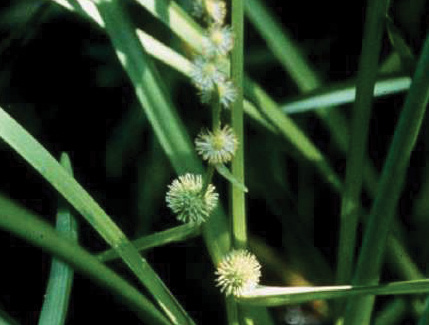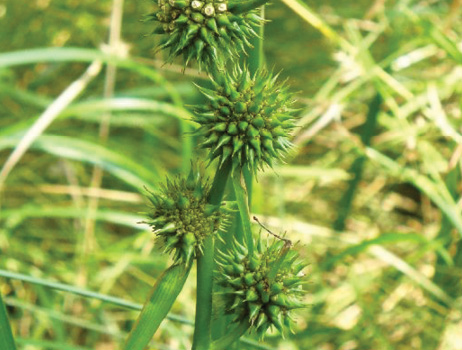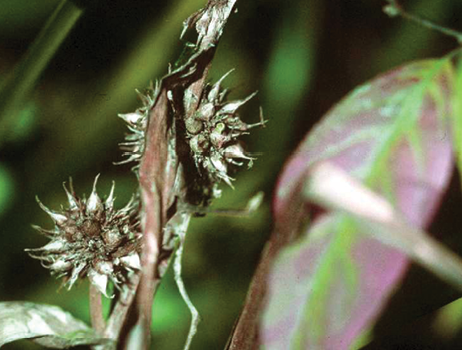American Bur-reed | Sparganium americanum
Emergent | Native



American bur-reed is a perennial plant native to the eastern half of the United States. Leaves are bright green, long, strap-like, and up to 1 inch wide.
Flowers are up to 1 inch in diameter, formed from a spherical bur-like structure that starts off green and becomes brown. Flowers are found in loose clusters. The seeds are dry with one seed per flower structure, which does not open to release the seed.
The overall plant stands upright and can be up to 2 feet tall. It grows in calm, shallow waters with partial shade. This plant can form dense stands along shallow shorelines.
Management Value
This plant rarely causes problems in recreational ponds and is an important food source for many marsh bird species, including waterfowl. Muskrats can eat the entire plant. The flowers attract many species of insects, including butterflies and other native pollinators.
The plant can provide shallow water habitat for juvenile fish and invertebrates, which are eaten by larger fish.
Recommended Controls
Herbicide efficacy is not listed for American bur-reed, but the following have been most successful in controlling this species.
Option 1: Diquat (3.73-pound formulation). Diquat (0.25 gallon per acre-foot of water) should be applied as a submersed injection (application using a wand or hose). Determine pond volume prior to application. Do not exceed annual herbicide rate limits as stated on the product label.
NOTE: Acre foot = average depth of pond multiplied by pond acreage; average depth is calculated by taking the depth at 20 points across a water body and averaging the values.
Read and follow all chemical label instructions, especially the section on the use of personal protection equipment.
Photo Credits Top: Robert H. Mohlenbrock. Provided by USDA NRCS Wetland Science Institute, Fort Worth; Middle: Jeff McMillian. Provided by Almost Eden, Louisiana; Bottom: Milo Pyne. Provided by USDA NRCS Wetland Science Institute, Fort Worth.

The information given here is for educational purposes only. References to commercial products, trade names, or suppliers are made with the understanding that no endorsement is implied and that no discrimination against other products or suppliers is intended.
Publication 3735-15 (POD-11-23)
By Wes Neal, PhD, Extension/Research Professor, Wildlife, Fisheries, and Aquaculture; Dennis Riecke, Fisheries Coordinator, Mississippi Department of Wildlife, Fisheries, and Parks; and Gray Turnage, PhD, Assistant Research/Extension Professor, GeoSystems Research Institute.
The Mississippi State University Extension Service is working to ensure all web content is accessible to all users. If you need assistance accessing any of our content, please email the webteam or call 662-325-2262.



